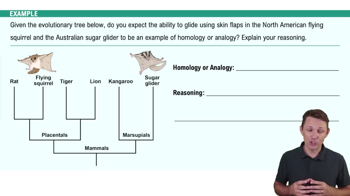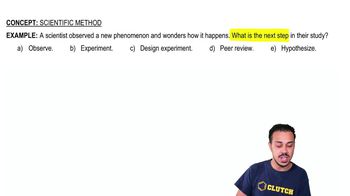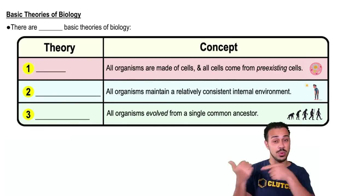Table of contents
- 1. Introduction to Biology2h 42m
- 2. Chemistry3h 40m
- 3. Water1h 26m
- 4. Biomolecules2h 23m
- 5. Cell Components2h 26m
- 6. The Membrane2h 31m
- 7. Energy and Metabolism2h 0m
- 8. Respiration2h 40m
- 9. Photosynthesis2h 49m
- 10. Cell Signaling59m
- 11. Cell Division2h 47m
- 12. Meiosis2h 0m
- 13. Mendelian Genetics4h 44m
- Introduction to Mendel's Experiments7m
- Genotype vs. Phenotype17m
- Punnett Squares13m
- Mendel's Experiments26m
- Mendel's Laws18m
- Monohybrid Crosses19m
- Test Crosses14m
- Dihybrid Crosses20m
- Punnett Square Probability26m
- Incomplete Dominance vs. Codominance20m
- Epistasis7m
- Non-Mendelian Genetics12m
- Pedigrees6m
- Autosomal Inheritance21m
- Sex-Linked Inheritance43m
- X-Inactivation9m
- 14. DNA Synthesis2h 27m
- 15. Gene Expression3h 20m
- 16. Regulation of Expression3h 31m
- Introduction to Regulation of Gene Expression13m
- Prokaryotic Gene Regulation via Operons27m
- The Lac Operon21m
- Glucose's Impact on Lac Operon25m
- The Trp Operon20m
- Review of the Lac Operon & Trp Operon11m
- Introduction to Eukaryotic Gene Regulation9m
- Eukaryotic Chromatin Modifications16m
- Eukaryotic Transcriptional Control22m
- Eukaryotic Post-Transcriptional Regulation28m
- Eukaryotic Post-Translational Regulation13m
- 17. Viruses37m
- 18. Biotechnology2h 58m
- 19. Genomics17m
- 20. Development1h 5m
- 21. Evolution3h 1m
- 22. Evolution of Populations3h 52m
- 23. Speciation1h 37m
- 24. History of Life on Earth2h 6m
- 25. Phylogeny2h 31m
- 26. Prokaryotes4h 59m
- 27. Protists1h 12m
- 28. Plants1h 22m
- 29. Fungi36m
- 30. Overview of Animals34m
- 31. Invertebrates1h 2m
- 32. Vertebrates50m
- 33. Plant Anatomy1h 3m
- 34. Vascular Plant Transport1h 2m
- 35. Soil37m
- 36. Plant Reproduction47m
- 37. Plant Sensation and Response1h 9m
- 38. Animal Form and Function1h 19m
- 39. Digestive System1h 10m
- 40. Circulatory System1h 57m
- 41. Immune System1h 12m
- 42. Osmoregulation and Excretion50m
- 43. Endocrine System1h 4m
- 44. Animal Reproduction1h 2m
- 45. Nervous System1h 55m
- 46. Sensory Systems46m
- 47. Muscle Systems23m
- 48. Ecology3h 11m
- Introduction to Ecology20m
- Biogeography14m
- Earth's Climate Patterns50m
- Introduction to Terrestrial Biomes10m
- Terrestrial Biomes: Near Equator13m
- Terrestrial Biomes: Temperate Regions10m
- Terrestrial Biomes: Northern Regions15m
- Introduction to Aquatic Biomes27m
- Freshwater Aquatic Biomes14m
- Marine Aquatic Biomes13m
- 49. Animal Behavior28m
- 50. Population Ecology3h 41m
- Introduction to Population Ecology28m
- Population Sampling Methods23m
- Life History12m
- Population Demography17m
- Factors Limiting Population Growth14m
- Introduction to Population Growth Models22m
- Linear Population Growth6m
- Exponential Population Growth29m
- Logistic Population Growth32m
- r/K Selection10m
- The Human Population22m
- 51. Community Ecology2h 46m
- Introduction to Community Ecology2m
- Introduction to Community Interactions9m
- Community Interactions: Competition (-/-)38m
- Community Interactions: Exploitation (+/-)23m
- Community Interactions: Mutualism (+/+) & Commensalism (+/0)9m
- Community Structure35m
- Community Dynamics26m
- Geographic Impact on Communities21m
- 52. Ecosystems2h 36m
- 53. Conservation Biology24m
1. Introduction to Biology
Scientific Method
Problem 3`
Textbook Question
A scientific hypothesis is ________.
a. An opinion
b. A proposed explanation for an observation
c. A fact
d. Easily proved true
e. An idea proposed by a scientist
 Verified step by step guidance
Verified step by step guidance1
Understand the definition of a scientific hypothesis: A scientific hypothesis is a testable and falsifiable proposed explanation for a specific observation or phenomenon.
Eliminate options that do not align with the definition of a hypothesis. For example, a hypothesis is not an opinion (option a) because opinions are subjective and not necessarily testable.
Consider whether a hypothesis is a fact (option c). A fact is a confirmed observation, while a hypothesis is a proposed explanation that requires testing.
Evaluate whether a hypothesis is 'easily proved true' (option d). Hypotheses are not easily proved true; they are tested through experiments and can be supported or refuted based on evidence.
Analyze whether a hypothesis is simply 'an idea proposed by a scientist' (option e). While scientists propose hypotheses, the key characteristic is that it must be testable and falsifiable, making option b the most accurate choice.
 Verified video answer for a similar problem:
Verified video answer for a similar problem:This video solution was recommended by our tutors as helpful for the problem above
Video duration:
40sPlay a video:
Was this helpful?
Key Concepts
Here are the essential concepts you must grasp in order to answer the question correctly.
Scientific Hypothesis
A scientific hypothesis is a testable statement that provides a proposed explanation for a specific observation or phenomenon. It is formulated based on existing knowledge and observations, and it serves as a starting point for further investigation. Unlike opinions, hypotheses must be based on empirical evidence and can be supported or refuted through experimentation.
Recommended video:
Guided course

Scientific Method
Testability
Testability refers to the ability of a hypothesis to be tested through experiments or observations. A hypothesis must be structured in a way that allows for empirical validation, meaning it can be supported or disproven by data. This characteristic distinguishes scientific hypotheses from mere opinions or untestable ideas.
Recommended video:
Guided course

Predictions, Hypotheses, & Theories
Empirical Evidence
Empirical evidence is information acquired by observation or experimentation that can be used to support or refute a hypothesis. It is crucial in the scientific method, as it provides the basis for validating claims and theories. The reliance on empirical evidence ensures that scientific conclusions are grounded in observable reality rather than speculation.
Recommended video:

Evidence of Evolution Example 1
Related Videos
Related Practice












